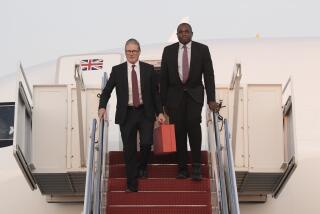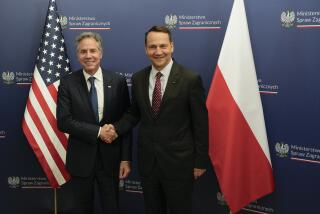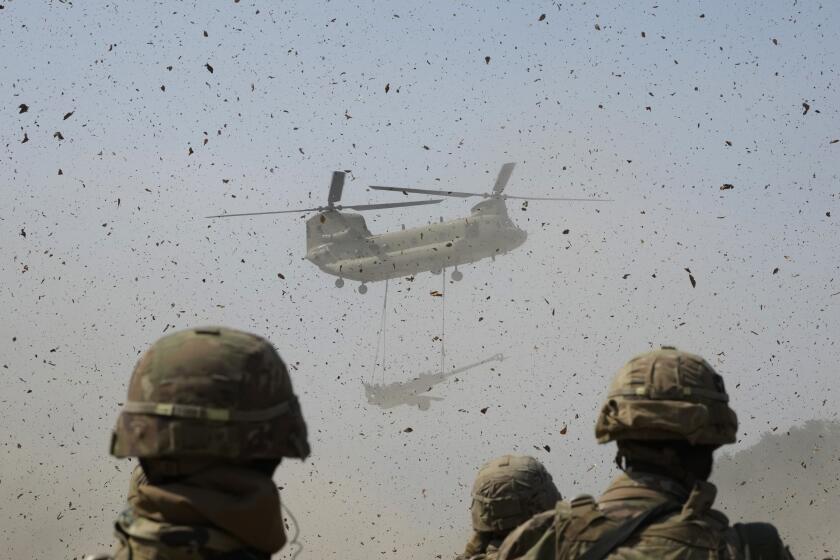Shultz, Soviets to Discuss Arms, Other Key Issues
- Share via
WASHINGTON — Secretary of State George P. Shultz flies to Moscow this weekend in an effort to resume progress toward a new U.S.-Soviet strategic arms reduction agreement, which has been largely stalled--if not marginally reversed--since the December summit meeting here.
But while the White House is likely to give Shultz somewhat more flexible proposals to take with him, there are decreasing expectations that a new treaty will be achieved by the Reagan Administration, some U.S. officials conceded privately this week.
Shultz also will discuss issues affecting regional conflicts, including the latest Soviet plan to withdraw from Afghanistan, continuing U.S. efforts to impose an international arms embargo on Iran in order to end its war with Iraq and the new U.S. peace initiative in the Middle East, a senior U.S. official said Wednesday.
“We will not be asking the Soviets for specific support for a specific U.S. idea” to end the Israeli-Arab conflict, the official said. “But it would be wrong to say we’re not interested in their views and their behavior in the Mideast.”
On the Afghanistan issue, Pakistan and the Afghan rebels are balking at the new Soviet withdrawal plan until a new government is formed in Kabul to replace the Soviet-backed regime there. U.S. officials will be discussing all aspects of the proposed settlement with Pakistan and the rebels this week “to shape what we will take to Moscow,” the official said.
Rights Issue Included
Shultz will also take up human rights issues, including Jewish emigration, during his three-day visit to Moscow beginning Sunday, and plans to meet with the best-known Soviet dissident, Nobel laureate Andrei D. Sakharov, as well as with citizens refused permission to emigrate, the official said.
But considerable effort will also be made to bring new energy to the arms discussions, which “have run a little flat,” the official admitted, since the last summit between President Reagan and Soviet leader Mikhail S. Gorbachev. A National Security Council meeting is expected to provide Shultz with new negotiating instructions before he leaves Friday.
In the warm afterglow of the summit meeting, senior U.S. officials offered 50-50 odds that strategic arms reduction talks, known as START, could produce a new treaty that could be signed by the next summit, scheduled for Moscow in late May or early June. Now, however, many are sounding less optimistic, and those who were initially dubious about such a rapid timetable are openly skeptical or worse.
Among the factors that have caused the change, they said, are:
-- High-level Administration preoccupation with congressional ratification of the U.S.-Soviet medium-range missile agreement to eliminate all nuclear-armed missiles with ranges between 300 and 3,400 miles. “They didn’t appreciate how much of their time the ratification process would take,” one official said, “time taken from work on a new treaty.”
-- Warnings from key congressmen, both conservative Republicans and moderates such as presidential contender Bob Dole of Kansas, to move more slowly on negotiations that would cut in half the long-range nuclear offensive weapons of both sides. Opponents of the medium-range missile treaty, another official said, “are really out to slow down the START talks.”
Sen. Bill Bradley (D-N.J.), a member of the Intelligence Committee, said in a breakfast interview with The Times’ Washington Bureau that Reagan already may have run out of time to reach a strategic weapons agreement before he leaves office next year. Although Bradley said he hopes that a new nuclear arms reduction pact can be negotiated in Geneva this year, he noted at the Tuesday session that “there’s a very short calendar left.”
-- An impasse at the Geneva negotiations, despite new instructions from the Reagan-Gorbachev meeting in December. The Soviets have even backed away from earlier concessions on a few issues, officials said, although these may be just bargaining postures. But the lack of progress also has been caused by the new tendency on both sides to conduct serious negotiations at the summit or at meetings between Shultz and Soviet Foreign Minister Eduard A. Shevardnadze.
Outstanding Issues
In the strategic arms talks, which involve missiles with ranges greater than 3,400 miles, the two sides have gone far in principle toward a new agreement that would limit each to 1,600 missiles and bombers that could carry a total of 6,000 warheads. But significant issues are still outstanding, including:
-- Mobile intercontinental ballistic missiles. The United States initially proposed banning these weapons, even though the Soviets are already deploying ICBMs on large highway vehicles and railroad cars, because of the difficulty in verifying their numbers. But it has invited the Soviets to propose an acceptable verification plan for the missiles, in which case it would reconsider its objections.
Meanwhile, the Pentagon has come to favor putting about 50 of its newest ICBM, the MX, on rails, to be kept on military bases and “flushed,” or dispersed, onto civilian rail lines in a crisis. U.S. experts have also concluded that road-mobile missiles are easier to monitor than rail-mobile weapons.
If the Soviets accept a comparable “garrison-basing mode” for its rail-mobile SS-24 missiles, one U.S. official said, the United States might withdraw its opposition to the mobile ICBMs.
-- Sea-launched cruise missiles. The Soviets initially wanted to ban the winged, pilotless weapons outright, while the United States wanted no limits. But at the December summit, the two sides agreed to “find a mutually acceptable solution” to nuclear-armed SLCMs, including a ceiling on the weapons and effective verification methods.
Much like its position on mobile ICBMs, the United States maintains that inspectors cannot distinguish between nuclear-tipped and conventionally armed SLCMs without unacceptably intrusive methods and has invited the Soviets to propose an acceptable scheme.
The Pentagon plans to deploy about 4,000 SLCMs, almost 800 of them nuclear-armed. Recently in Geneva, the Soviets proposed a limit of 400 nuclear and 600 conventional SLCMs for each side. U.S. officials considered that a regressive move because it reintroduces an effort to limit conventional SLCMs, despite summit references only to nuclear SLCMs.
-- Air-launched cruise missiles. The Soviets want to limit these weapons to a range of 375 miles, which the United States opposes. Another problem is counting how many ALCMs a bomber carries. Because aircraft carry different loadings depending on their daily assignments, the United States wants each ALCM-carrying bomber to count as if it had six ALCMs--and thus six warheads--even though some U.S. B-52s are being outfitted to carry up to 20. The Soviets want each ALCM bomber counted as if it carried its maximum possible load.
-- Sublimits on ICBMs. The United States wants a ceiling of between 3,000 and 3,300 warheads on these fastest, most accurate nuclear weapons, in which the Soviets have an advantage. The Soviets said they will agree if a comparable limit is placed on submarine-launched ballistic missiles, in which the United States has an advantage. One option put before Reagan this week is for the United States to withdraw its proposal because the two sides have already agreed to a 4,900 limit on ICBMs and SLBMs combined.
More to Read
Sign up for Essential California
The most important California stories and recommendations in your inbox every morning.
You may occasionally receive promotional content from the Los Angeles Times.












